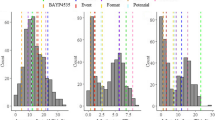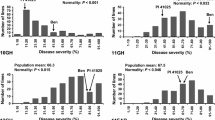Abstract
Quantitative trait loci (QTL) involved in the resistance of maize to Setosphaeria turcica, the causal agent of northern leaf blight, were located by interval mapping analysis of 121 F2:3 lines derived from a cross between Mo17 (moderately resistant) and B52 (susceptible). A linkage map spanning 112 RFLP loci with 15 cM mean interval length was constructed, based on marker data recorded in a previous study. Field tests with artificial inoculation were conducted at three sites in tropical mid- to high-altitude regions of Kenya, East Africa. Host-plant response was measured in terms of incubation period, disease severity (five scoring dates), and the area under the disease progress curve (AUDPC). Heritability of all traits was high (around 0.75). QTL associated with the incubation period were located on chromosomes 2S and 8L. For disease severity and AUDPC, significant QTL were detected in the putative centromeric region of chromosome 1 and on 2S, 3L, 5S, 6L, 7L, 8L and 9S. On 2S the same marker interval which carried a gene enhancing latent period was also associated with reduced disease severity of juvenile plants. QTL on chromosomes 3L, 5S, 7L and 8L were significant across environments but all other QTL were affected by a large genotype x environment interaction. Partially dominant gene action for resistance as well as for susceptibility was prevailing. Single QTL explained 10 to 38% of the phenotypic variation of the traits. All but the QTL on chromosomes 1, 6 and 9 were contributed by the resistant parent Mo17. On chromosome 8L a QTL mapped to the same region as the major race-specific gene Ht2, supporting the hypothesis that some qualitative and quantitative resistance genes may be allelic.
Similar content being viewed by others
Abbreviations
- AUDPC:
-
area under the disease progress curve
- CIMMYT:
-
International Maize and Wheat Improvement Center
- KARI:
-
Kenya Agricultural Research Institute
- NCLB:
-
northern corn leaf blight
- QTL:
-
quantitative trait locus/loci
References
Adipala E, Lipps PE, Madden LV: Occurrence of Exserohilum turcicum on maize in Uganda. Plant Dis 77: 202–205 (1993).
Adipala E, Lipps PE, Madden LV: Reaction of maize cultivars from Uganda to Exserohilum turcicum. Phytopathology 83: 217–223 (1993).
Allard RW: Principles of Plant Breeding. John Wiley, New York (1960).
Bentolila S, Guitton C, Bouvet N, Sailland A, Nykaza S, Freyssinet G: Identification of an RFLP marker tightly linked to the Htl gene in maize. Theor Appl Genet 82: 393–398 (1991).
Brewster VA, Carson ML, WicksIII ZW: Mapping components of partial resistance to northern leaf blight of maize using reciprocal translocations. Phytopathology 82: 225–229 (1992).
Carson ML: Inheritance of latent period length in maize infected with Exserohilum turcicum. Plant Dis 79: 581–585 (1995).
Carson ML: A new gene in maize conferring the ‘chlorotic halo’ reaction to infection by Exserohilum turcicum. Plant Dis 79: 717–720 (1995).
Cochran WG, Cox GM: Experimental Designs. Wiley, New York (1957).
Dingerdissen AL: Kartierung quantitativer Resistenzgene gegen Setosphaeria turcica, Erreger des Northern Corn Leaf Blight, in Mais. Diploma thesis, University of Hohenheim (1995).
Fisher DE, Hooker AL, Lim SL, Smith DR: Leaf infection and yield loss caused by four Helminthosporium leaf diseases of corn. Phytopathology 66: 942–944 (1976).
Freymark PJ, Lee M, Woodman WL, Martinson CA: Quantitative and qualitative trait loci affecting host-plant response to Exserohilum turcicum in maize (Zea mays L.). Theor Appl Genet 87: 537–544 (1993).
Freymark PJ, Lee M, Martinson CA, Woodman WL: Molecular-marker-facilitated investigation of host-plant response to Exserohilum turcicum in maize (Zea mays L.): components of resistance. Theor Appl Genet 88: 305–313 (1994).
Geiger HH, Heun M: Genetics of quantitative resistance to fungal diseases. Annu Rev Phytopath 27: 317–341 (1989).
Gevers HO: A new major gene for resistance to Helminthosporium turcicum leaf blight of maize. Plant Dis Rep 59: 296–299 (1975).
Haley CS, Knott SA: A simple regression method for mapping quantitative trait loci in line crosses using flanking markers. Heredity 69: 315–324 (1992).
Hallauer AR, Miranda JB: Quantitative Genetics in Maize Breeding. Iowa State University Press, Ames, Iowa (1981).
Helentjaris T, Weber D, Wright S: Use of monosomics to map cloned DNA fragments in maize. Proc Natl Acad Sci USA 83: 6035–6039 (1986).
Hooker AL: Monogenic resistance in Zea mays L. to Helminthosporium turcicum. Crop Sci 3: 787–788 (1963).
Hooker AL: A second major gene locus in corn for chlorotic-lesion resistance to Helminthosporium turcicum. Crop Sci 17: 132–135 (1977).
Hooker AL, Perkins JM: Helminthosporium leaf blights of corn: the state of the art. Proc Annu Corn Sorghum Res Conf 35: 68–87 (1980).
Hughes GR, Hooker AL: Gene action conditioning resistance to northern leaf blight in maize. Crop Sci 11: 180–184 (1971).
Jansen RC: Mapping of quantitative trait loci by using genetic markers: an overview of biometrical methods. In: van Ooijen JW, Jansen J (eds) Biometrics in Plant Breeding: Applications of Molecular Markers, pp. 116–124. Wageningen, Netherlands (1994).
Jenkins MT, Robert AL: Inheritance of resistance to the leaf blight of corn caused by Helminthosporium turcicum. Agronomy J 44: 136–140 (1952).
Jenkins MT, Robert AL: Further genetic studies of resistance to Helminthosporium turcicum Pass. in maize by means of chromosomal translocations. Crop Sci 1: 450–455 (1961).
Jenkins MT, Robert AL, Findley WRJr: Inheritance of resistance to Helminthosporium turcicum leaf blight in populations of F3 progenies. Agronomy J 44: 438–442 (1952).
Jenkins MT, Robert AL, Findley WRJr: Genetic studies of resistance to Helminthosporium turcicum in maize by means of chromosomal translocations. Agron J 49: 197–201 (1957).
Knapp SJ, Bridges WLJr: Confidence interval estimates for heritability for several mating and experimental designs. Theor Appl Genet 73: 759–763 (1985).
Lander ES, Botstein D: Mapping Mendelian factors underlying quantitative traits using RFLP linkage maps. Genetics 121: 185–199 (1989).
Leonard KJ, Levy Y: Yield loss in sweet corn in response to defoliation or infection by Exserohilum turcicum. J Phytopath 128: 161–171 (1990).
Leonard KJ, Levy Y, Smith DR: Proposed nomenclature for pathogenic races of Exserohilum turcicum on corn. Plant Dis 73: 776–777 (1989).
Leonards-Schippers C, Gieffers W, Schäfer-Pregl R, Ritter E, Knapp SJ, Salamini F, Gebhardt C: Quantitative resistance to Phytophthora infestans in potato: a case study for QTL mapping in an allogamous plant species. Genetics 137: 67–77 (1994).
Levy Y, Pataky JK: Epidemiology of northern leaf blight on sweet corn. Phytoparasitica 20: 53–66 (1992).
Lincoln SE, Lander ES: Systematic detection of errors in genetic linkage data. Genomics 14: 604–610 (1992).
Lincoln SE, Daly M, Lander ES: Constructing genetic maps with MAPMAKER/EXP 3.0. Whitehead Institute Technical Report, 3rd ed. (1992).
Lincoln SE, Daly M, Lander ES: Mapping genes controlling quantitative traits with MAPMAKER/QTL 1.1. Whitehead Institute Technical Report, 2nd ed. (1992).
Lothrop JE: The CIMMYT headquarters highland maize program. In: Gebrekidan B (ed) Maize Improvement, Production and Protection in Eastern and Southern Africa. Proceedings 3rd Eastern and Southern Africa Regional Maize Workshop, pp. 75–92. Nairobi, Kenya (1990).
Mather K, Jinks JL: Biometrical Genetics, 2nd ed. Chapman and Hall, London (1971).
Mode CJ, Robinson HF: Pleiotropism and the genetic variance and covariance. Biometrics 15: 518–537 (1959).
van Ooijen JW: Accuracy of mapping quantitative trait loci in autogamous species. Theor Apl Genet 84: 803–811 (1992).
Patterson HD, Williams ER: A new class of resolvable incomplete block designs. Biometrika 63: 83–92 (1976).
Pratt RC, Adipala E, Lipps PE: Characterization of race-nonspecific resistance to Exserohilum turcicum races 0 and 1 in maize OhS10 S1 progenies. Plant Dis 77: 1227–1232 (1993).
Robertson DS: Understanding the relationship between qualitative and quantitative genetics. In: Helentjaris T, Burr B (eds) Development and Application of Molecular Markers to Problems in Plant Genetics, pp. 81–87. Cold Spring Harbor Laboratory, Cold Spring Harbor, NY (1989).
SAS Institute Inc: SAS User's Guide Statistics, Release 6.03. SAS Institute, Cary, NC (1988).
Schön CC, Melchinger AE, Boppenmaier J, Brunklaus-Jung E, Herrmann RG, Seitzer JF: RFLP mapping in maize: quantitative trait loci affecting testcross performance of elite European flint lines. Crop Sci 34: 378–389 (1994).
Shaner G, Finney RE: New sources of slow leaf rusting resistance in wheat. Phytopathology 70: 1183–1186 (1980).
Simcox KD, Bennetzen JL: The use of molecular markers to study Setosphaeria turcica resistance in maize. Phytopathology 83: 1326–1330 (1993).
Smith DR, Kinsey JG: Latent period: a possible selection tool for Exserohilum turcicum resistance in corn (Zea mays L.). Maydica 38: 205–208 (1993).
Snedecor GW, Cochran WG: Statistical Methods. Iowa Institute University Press, Ames, Iowa (1967).
Stuber CW, Lincoln SE, Wolff DW, Helentjaris T, Lander ES: Identification of genetic factors contributing to heterosis in a hybrid from two elite maize inbred lines using molecular markers. Genetics 132: 823–839 (1992).
Utz HF: Plabstat Version 2H. Institut für Pflanzenzüchtung, Saatgutforschung und Populationsgenetik, Universität Hohemheim (1993).
Utz HF: Plabcov. Institut für Pflanzenzüchtung, Saatgutforschung und Populationsgenetik, Universität Hohenheim (1994).
Utz HF, Melchinger AE: Comparison of different approaches to interval mapping of quantitative trait loci. In: van Ooijen JW, Jansen J (eds) Biometrics in Plant Breeding: Applications of Molecular Markers, pp. 195–204. Wageningen, Netherlands (1994).
Wang GL, Mackill DJ, Bonman JM, McCough SR, Champoux MC, Nelson RJ: RFLP mapping of genes conferring complete and partial resistance to blast in a durably resistant rice cultivar. Genetics 136: 1421–1434 (1994).
Weber D, Henlentjaris T: Mapping RFLP loci in maize using B-A translocations. Genetics 121: 583–590 (1989).
Welz HG, Geiger HH: Globale Variation und Genetik des qualitativen Virulenz von Setosphaeria turcica, dem Erreger des ‘Northern Corn Leaf Blight’. Berichte 46. Tagung Vereinigung Österreichischer Pflanzenzüchter 1995, Gumpenstein (in press).
Zaitlin D, Demars SJ, Gupta M: Linkage of a second gene for NCLB resistance to molecular markers in maize. Maize Genet Coop Newslett 66: 69–70 (1992).
Zuber MS: Registration of parental lines. Crop Sci 13: 779–780 (1973).
Author information
Authors and Affiliations
Rights and permissions
About this article
Cite this article
Dingerdissen, A.L., Geiger, H.H., Lee, M. et al. Interval mapping of genes for quantitative resistance of maize to Setosphaeria turcica, cause of northern leaf blight, in a tropical environment. Mol Breeding 2, 143–156 (1996). https://doi.org/10.1007/BF00441429
Received:
Accepted:
Issue Date:
DOI: https://doi.org/10.1007/BF00441429




